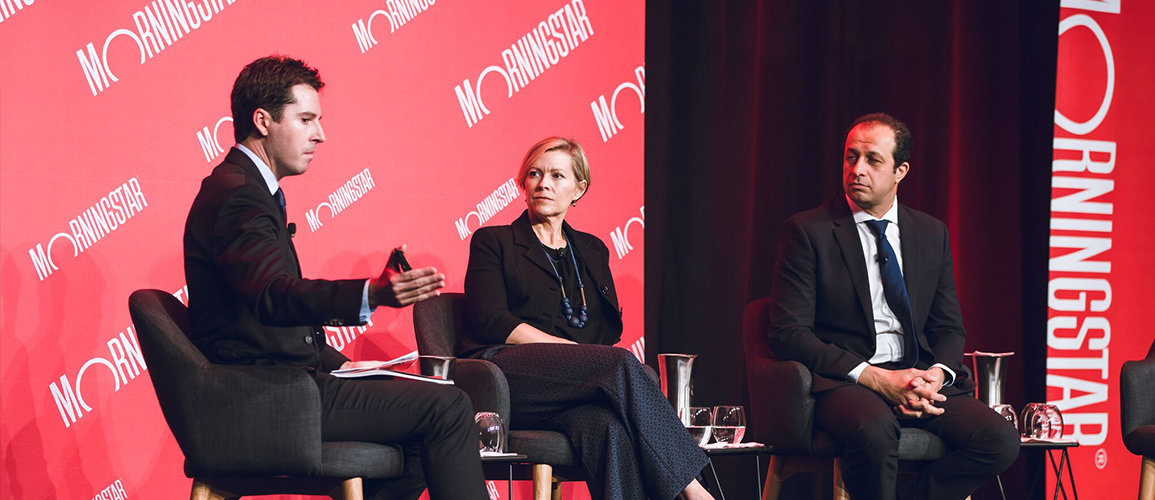Kate Howitt, portfolio manager at Fidelity International, and Vince Pezzullo, Perpetual’s deputy head of equities, discussed the expensiveness of the Australian market, potential value traps, and the difficulty in defensively positioning portfolios in the current market environment at the 2018 Morningstar Investment Conference. Howitt manages Fidelity Australian Opportunities 19483, and Pezzullo runs the flagship strategy Perpetual Wholesale Australian Share 4361.
The Australian market has seen strong growth for almost a decade, which has raised concerns over valuations. Howitt emphasized the importance of identifying long-term opportunities, even if they may look expensive on short-term metrics. Howitt used A2 as an example, which she purchased a position for Fidelity Australian Opportunities in 2015. A2 Milk was cash-generative, demonstrated growing market share, and had strong management. True-to-label, this was in line with Howitt’s emphasis on valuation metrics, a company’s potential growth, and the sustainability of that growth. Such strong performers come with the risk of derating, however, as we saw in early 2018. A2 was a part of this, but Howitt felt that the stock was pricing in aggressive growth targets and exited the position in December 2017. Pezzullo went as far to say that anything above 25 price/earnings is speculating, and that investors should always think about “what can go wrong” with a stock. In fact, Pezzullo prefers to find opportunities in unloved stocks, such as Woolworths in late 2015 when the market had given up on it.
This highlights the greater emphasis Perpetual puts on valuation factors compared to Howitt. The holdings-based style trail shown in Figure 1 demonstrates this—the Perpetual strategy has a value tilt compared with Fidelity’s growth-leaning portfolio.
Figure 1 - Source: Morningstar Direct
 But Howitt and Pezzullo both agreed that while there is a clustering of expensive stocks in certain sectors, there are also pockets of opportunities. Pezzullo described the market as bifurcated into expensive stocks and cheap stocks, but emphasized that the latter can often be value traps. The manager used Telstra to illustrate this. Pezzullo believes that Telstra may appear cheap, but poor management and corporate strategy are letting it down. Telstra has already cut its dividend (2017) and its earnings were downgraded mid-May 2018. Howitt added that the communications industry is very capital-intensive, and while firms like Telstra invest in the physical infrastructure (for example, fibre networks), others that have asset-light returns such as Facebook and Netflix benefit the most.
Banks were next. The managers argued that while these seem good value, their business models are challenged. Specifically, fines and sanctions borne from the Royal Commission have taken a toll, and regulatory uncertainty continues to loom. In a “best-case” scenario, however, Howitt argued that banks remain cash-generative, high-yielding stocks with limited earnings growth potential. So for investors looking for exposure similar to that of utility stocks, banks may have a role to play.
Overall, the Australian market still looks expensive compared with the start of 2009. That posed the question: How do you position the portfolio for defensiveness if the market comes off? According to Howitt, this task is particularly difficult in the current low-interest-rate environment. Given that traditional defensive businesses typically behave as bond proxies, the threat of rising rates makes these companies most vulnerable. This includes some listed property and infrastructure names, which don’t see enough cash flow growth coming through to keep up with rising rates. The discussion highlighted that while there is no simple solution to defensively position an equity portfolio, active managers now have an opportunity to prove their worth and navigate the challenging market environment.
The session ended with an audience poll, which revealed that investors were looking to either keep their Australian equities exposure the same or reduce it going forward.
But Howitt and Pezzullo both agreed that while there is a clustering of expensive stocks in certain sectors, there are also pockets of opportunities. Pezzullo described the market as bifurcated into expensive stocks and cheap stocks, but emphasized that the latter can often be value traps. The manager used Telstra to illustrate this. Pezzullo believes that Telstra may appear cheap, but poor management and corporate strategy are letting it down. Telstra has already cut its dividend (2017) and its earnings were downgraded mid-May 2018. Howitt added that the communications industry is very capital-intensive, and while firms like Telstra invest in the physical infrastructure (for example, fibre networks), others that have asset-light returns such as Facebook and Netflix benefit the most.
Banks were next. The managers argued that while these seem good value, their business models are challenged. Specifically, fines and sanctions borne from the Royal Commission have taken a toll, and regulatory uncertainty continues to loom. In a “best-case” scenario, however, Howitt argued that banks remain cash-generative, high-yielding stocks with limited earnings growth potential. So for investors looking for exposure similar to that of utility stocks, banks may have a role to play.
Overall, the Australian market still looks expensive compared with the start of 2009. That posed the question: How do you position the portfolio for defensiveness if the market comes off? According to Howitt, this task is particularly difficult in the current low-interest-rate environment. Given that traditional defensive businesses typically behave as bond proxies, the threat of rising rates makes these companies most vulnerable. This includes some listed property and infrastructure names, which don’t see enough cash flow growth coming through to keep up with rising rates. The discussion highlighted that while there is no simple solution to defensively position an equity portfolio, active managers now have an opportunity to prove their worth and navigate the challenging market environment.
The session ended with an audience poll, which revealed that investors were looking to either keep their Australian equities exposure the same or reduce it going forward.
 But Howitt and Pezzullo both agreed that while there is a clustering of expensive stocks in certain sectors, there are also pockets of opportunities. Pezzullo described the market as bifurcated into expensive stocks and cheap stocks, but emphasized that the latter can often be value traps. The manager used Telstra to illustrate this. Pezzullo believes that Telstra may appear cheap, but poor management and corporate strategy are letting it down. Telstra has already cut its dividend (2017) and its earnings were downgraded mid-May 2018. Howitt added that the communications industry is very capital-intensive, and while firms like Telstra invest in the physical infrastructure (for example, fibre networks), others that have asset-light returns such as Facebook and Netflix benefit the most.
Banks were next. The managers argued that while these seem good value, their business models are challenged. Specifically, fines and sanctions borne from the Royal Commission have taken a toll, and regulatory uncertainty continues to loom. In a “best-case” scenario, however, Howitt argued that banks remain cash-generative, high-yielding stocks with limited earnings growth potential. So for investors looking for exposure similar to that of utility stocks, banks may have a role to play.
Overall, the Australian market still looks expensive compared with the start of 2009. That posed the question: How do you position the portfolio for defensiveness if the market comes off? According to Howitt, this task is particularly difficult in the current low-interest-rate environment. Given that traditional defensive businesses typically behave as bond proxies, the threat of rising rates makes these companies most vulnerable. This includes some listed property and infrastructure names, which don’t see enough cash flow growth coming through to keep up with rising rates. The discussion highlighted that while there is no simple solution to defensively position an equity portfolio, active managers now have an opportunity to prove their worth and navigate the challenging market environment.
The session ended with an audience poll, which revealed that investors were looking to either keep their Australian equities exposure the same or reduce it going forward.
But Howitt and Pezzullo both agreed that while there is a clustering of expensive stocks in certain sectors, there are also pockets of opportunities. Pezzullo described the market as bifurcated into expensive stocks and cheap stocks, but emphasized that the latter can often be value traps. The manager used Telstra to illustrate this. Pezzullo believes that Telstra may appear cheap, but poor management and corporate strategy are letting it down. Telstra has already cut its dividend (2017) and its earnings were downgraded mid-May 2018. Howitt added that the communications industry is very capital-intensive, and while firms like Telstra invest in the physical infrastructure (for example, fibre networks), others that have asset-light returns such as Facebook and Netflix benefit the most.
Banks were next. The managers argued that while these seem good value, their business models are challenged. Specifically, fines and sanctions borne from the Royal Commission have taken a toll, and regulatory uncertainty continues to loom. In a “best-case” scenario, however, Howitt argued that banks remain cash-generative, high-yielding stocks with limited earnings growth potential. So for investors looking for exposure similar to that of utility stocks, banks may have a role to play.
Overall, the Australian market still looks expensive compared with the start of 2009. That posed the question: How do you position the portfolio for defensiveness if the market comes off? According to Howitt, this task is particularly difficult in the current low-interest-rate environment. Given that traditional defensive businesses typically behave as bond proxies, the threat of rising rates makes these companies most vulnerable. This includes some listed property and infrastructure names, which don’t see enough cash flow growth coming through to keep up with rising rates. The discussion highlighted that while there is no simple solution to defensively position an equity portfolio, active managers now have an opportunity to prove their worth and navigate the challenging market environment.
The session ended with an audience poll, which revealed that investors were looking to either keep their Australian equities exposure the same or reduce it going forward. 




